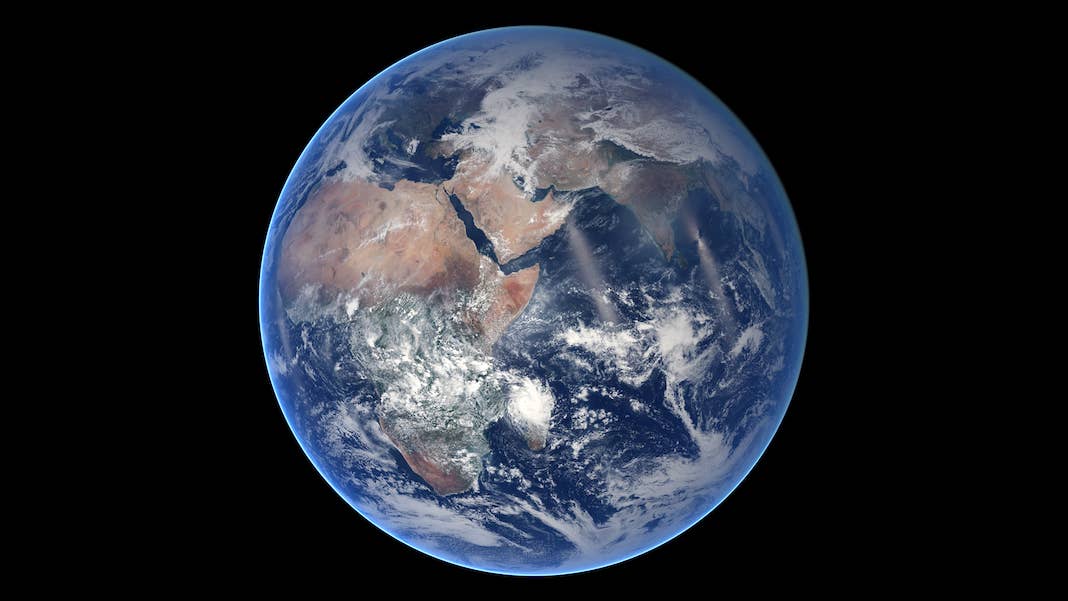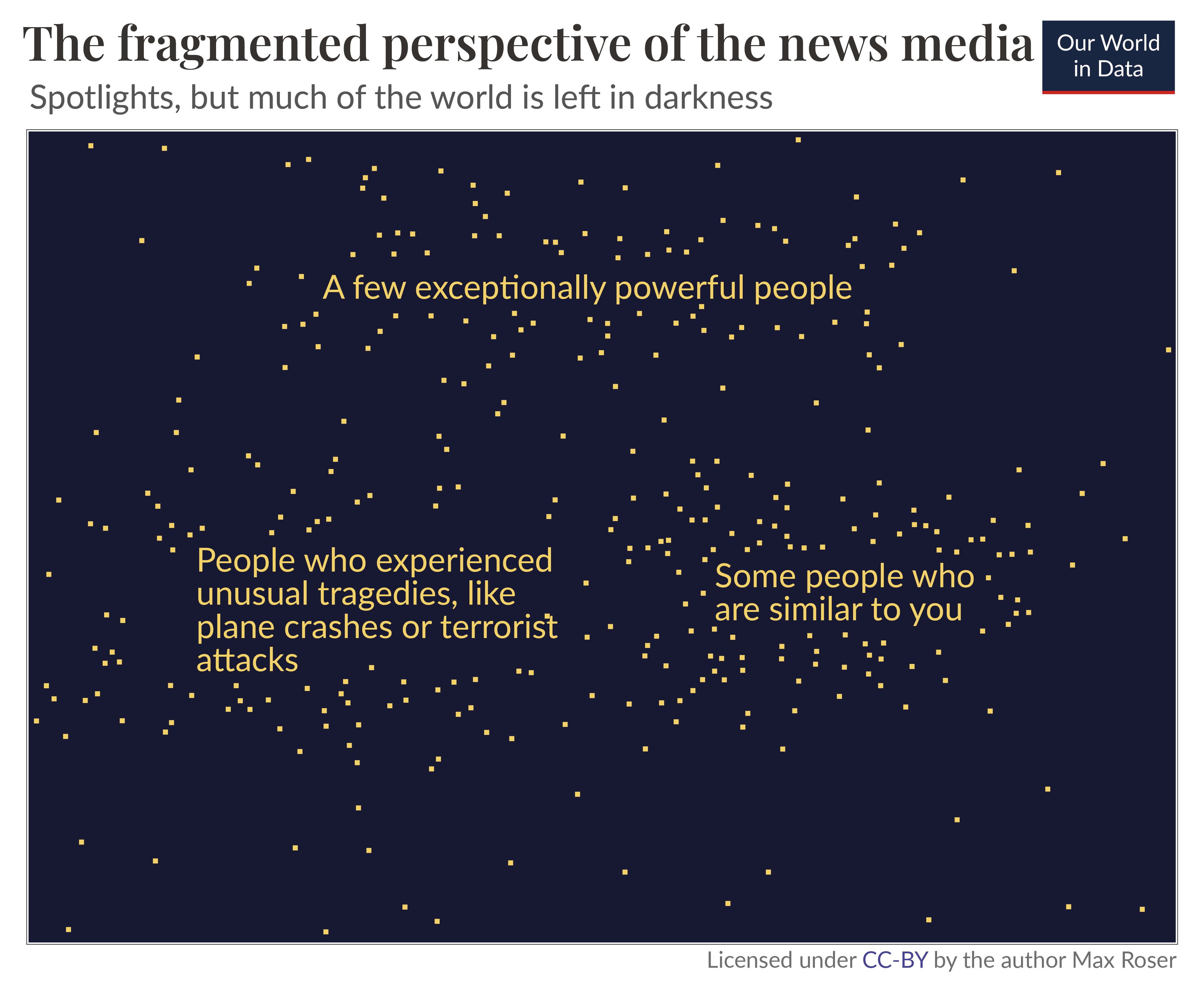The Limits of Our Personal Experience and the Value of Statistics
The world is huge; to get a clear idea of what our world is like, we have to rely on carefully collected, well-documented statistics.

Share
Originally published by Max Roser at Our World in Data. Republished here under a Creative Commons license.
It’s tempting to believe that we can simply rely on personal experience to develop our understanding of the world. But that’s a mistake. The world is large, and we can experience only very little of it personally. To see what the world is like, we need to rely on other means: carefully-collected global statistics.
Of course, our personal interactions are part of what informs our worldview. We piece together a picture of the lives of others around us from our interactions with them. Every time we meet people and hear about their lives, we add one more perspective to our worldview. This is a great way to see the world and expand our understanding, I don’t want to suggest otherwise. But I want to remind ourselves how little we can learn about our society through personal interactions alone, and how valuable statistics are in helping us build the rest of the picture.
The Horizon of Our Personal Experience
How many people do you know personally?
Let’s take a broad definition of what it means to know someone and say that we include everyone you know by name. A study in the US asked how many people Americans know by name and found that the average person knows 611.1
Let’s assume you are more social than the average American, and you know 800 people. In a world of 8 billion, this means that you know 0.00001% of the population. A 100,000th of a percent.2
It’s hard to visualize how small a fraction this is. If this illustration was drawn to scale, then the blue rectangle—which represents the world population—would be as large as a sheet of printer paper, while the yellow square—which represents the number that a person knows—would have the diameter of a human hair.3
This is why I’m very skeptical when people say things about “the world these days” based on what they hear from people they know.
We cannot see much of the world through our direct experience. The horizon of our personal experience is very narrow. For every person you know, there are ten million people you do not know.
And chances are that the people you know are quite similar to you, far from representative of the world—or your country—as a whole.

How Wide Can the Horizon of Our Personal Experience Be?
Perhaps you think restricting the people you learn from to the number of people you know by name is too narrow. After all, you also learn from strangers you meet, even if you don’t get to know their names.
Let’s assume you are exceptionally good at this, and you have a conversation with three new people every single day of your life.
If you can keep this up for 73 years, you will get to know 80,000 people.4 That’s more than a hundred times the number of people you’d know by name.
This is still a tiny fraction of the world. After a lifetime of speaking with people, you will have spoken to 0.001% of the world’s population. For every person you’ve had a conversation with, there are still 100,000 people you’ve never spoken to.
Drawn to scale, the orange square, which represents the number of people you could ever speak to, would be less than a millimeter (0.8mm) wide.5
I am focusing on personal interactions as the most direct and in-depth way to learn about others, but they are not the only experiences by which we learn about others. We also learn by seeing other peoples’ clothes, by seeing their houses, or by hearing others talk about their personal experiences. But while these experiences also help, they still don’t get us very far. The world is large, and even if you are exceptionally attentive and exceptionally good at making connections and speaking to people, it is simply impossible to see much of the world directly.

The Fragmented Perspective of the News Media: Some Spotlights on Particular People, But Much of the World Is Left in Darkness
The limits of our personal experience don’t reach far beyond ourselves. How can we know about the world if we want to see beyond this tight horizon?
In one way or another, we have to rely on the media. Whether it is television or radio, the newspaper or photography, books, podcasts, documentaries, research papers, statistical tables, or social media.
This fact is so obvious that it is easy to miss how important it is: everything you hear about anyone who is more than a few dozen meters away, you know through some form of media.
That’s why the media we choose to rely on is so important for our understanding of the world.
The news is the media that shapes our picture of the world more than any other. Today, it’s often intertwined with social media. It is valuable as it lets us see beyond our own tight horizon, but the view the news offers is a spotted and fragmented one.
The news reports on the unusual things that happen on a particular day, but the things that happen every day never get mentioned. This gives us a biased and incomplete picture of the world; we are inundated with detailed news on terrorism but hardly ever hear of everyday tragedies like the fact that 16,000 children die every single day.
The illustration below visualizes this fragmented view. The news focuses on exceptionally powerful people or on those who experienced unusual tragedies. But while it puts the spotlight on those few people, it leaves most of the world in darkness.
The problem is not so much what the news media covers but what it does not cover. Those left in darkness are often poor and powerless and geographically far from us. What we see in the news is not nearly enough to understand the world we are living in.
Be Part of the Future
Sign up to receive top stories about groundbreaking technologies and visionary thinkers from SingularityHub.



What Is Missing: Everyone Else—for This, We Need Global Data
Of course, it is challenging to hear about everyone. But that’s the challenge we have to take on if we don’t want to be left with a scattered and biased perspective of the world.
If we want to see what on earth is going on, we have to tell all the stories. This is possible. Telling many stories at once is statistics.
Statistical methods make it possible to draw reliable conclusions about a population as a whole. Statistics is an extraordinary cultural achievement that allows us to broaden our view, from the individual stories of those in the spotlight to a perspective that includes everyone.
Global economic data can tell us about the incomes of everyone on this planet. Global health data aim to tell us about everyone’s cause of death. And similarly, we can learn about everyone who lacks access to basic electricity, everyone who lacks access to clean drinking water, and everyone who lacks access to basic sanitation.
Global statistics don’t only allow us to see what the “world these days” looks like, but also how it has changed. Statistics that document how the world has changed are often very surprising to those who mostly rely on the news to understand the world. While the news focuses overwhelmingly on all the things that are going wrong, historical statistics allow us to also see what has gone right—the immense progress the world has achieved.
Statistics can illuminate the world in a way that our personal experiences and the news media can’t. This is why my colleagues and I at Our World in Data rely on global statistics to understand how the world is changing.
The visual below illustrates what carefully-collected global statistics make possible: they illuminate the entire world around us, and allow us to see what is happening to everyone.

No Data Is Perfect
The collection and production of good statistics is a major challenge. Data might be unrepresentative in some ways, it might be mismeasured, and some data might be missing entirely. Everyone who relies on statistics to form their worldview needs to be aware of these shortcomings.
Our goal at Our World in Data is to present the best available data and at the same time highlight their shortcomings. The most important work is done by the statisticians who collect and publish the global databases in the first place. Our role is to make their work accessible and understandable. To achieve this goal we speak with experts, read the scientific literature, and analyze the available data so that we can highlight the best available statistics and highlight the shortcomings that even the best data is associated with.
A Statistical Understanding of the World Needs to Become Much More Central to Our Culture
I don’t want to suggest that it is a bad idea to rely on personal experience or the news to learn about the world. Each way of learning about the world has its value. It’s about how we bring them together: the in-depth understanding that only personal interaction can give us, the focus on the powerful and unusual that the news offers, and the statistical view that gives us the opportunity to see everyone.
We have many ways of learning about the world and we should make use of all of them. A statistical view without personal experience lacks depth, and personal experience without statistical knowledge lacks perspective.
The problem is that most of our focus goes toward personal experience and the news. They are held in high regard, while statistics are left to a small corner of our culture. This is not where they belong. A society that has the aspiration to care for everyone needs to bring a statistical understanding of the world into the center of its culture.
For this, we need to remember what statistical figures really mean. Spreadsheets are not just numbers, they tell us about the reality of the people around us and allow us to see what is happening to everyone, all at once.
Image Credit: NASA
Max is the founder of Our World in Data and began working on this free online publication in 2011. Today, he serves as the publication’s editor and leads the team as its co-director.
He is the Professor of Practice in Global Data Analytics at the University of Oxford’s Blavatnik School of Government, the Programme Director of the Oxford Martin Programme on Global Development, and the Executive Co-Director of Global Change Data Lab, the non-profit organization that publishes Our World in Data.
Related Articles

How Will the Universe End? The Dark Eternity That Awaits Us Trillions of Years From Now

Data Centers in Space: Will 2027 Really Be the Year AI Goes to Orbit?

How Scientists Are Growing Computers From Human Brain Cells—and Why They Want to Keep Doing It
What we’re reading
